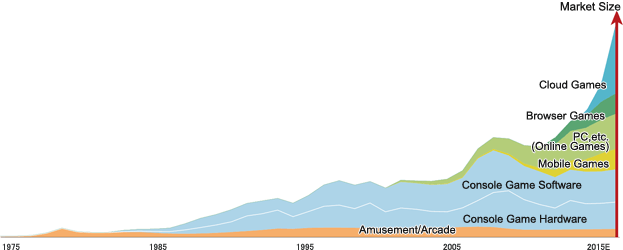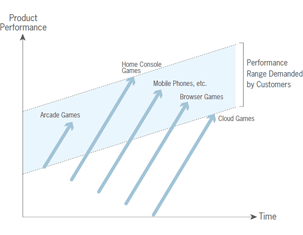Within the growth of the games industry, there is a clear trend appearing.
Games are an incredibly complex application, and making them work requires an environment of incredibly high capabilities. In order for a customer to play a game, such application software requires an investment in the operating environment, namely hardware. As the required investment in the environment is reduced, the entry barrier for consumers is lowered and the game industry grows (Figure 4).
Figure4: The Game Industry—Growing on Lower Investment Requirement to Play

Various sources compiled by the Company
In the early stages of the video game industry, making a game run was difficult and each individual game required its own unique hardware. To that end, arcade owners purchased machines, and the business model saw these owners spread the investment cost to their customers in the form of coin operations.
Next, Nintendo developed its Nintendo Entertainment System (NES), and the investment cost for the average consumer to own a game machine was greatly reduced. This was the birth of the home video game console industry.
From there, the console game market grew quickly as the capabilities of each game console advanced and third-party developers increased the overall supply of software.
In 2000, when the PlayStation 2 System was released, the concept of the game console as a games-only device disappeared. At one price, you gained both a game console and a DVD player, which had the effect of dramatically reducing the consumer’s investment in the environment specifically to play games.
In the years following, people gained the ability to play games on mobile phones in Japan. With this, we entered the age of general purpose devices capable of playing games.While PCs had been capable of playing games for some time, PCs with such extremely high specifications required by games began to serve as de facto game consoles. Now, however, we find that even average PCs are capable of allowing people to enjoy games as well.
Since the 2007 debut of the iPhone, smartphones and tablet PCs have spread rapidly, fully establishing the lifestyle of playing games on general purpose devices. Furthermore, around 2006, all game devices became connected to the Internet, which can be viewed as a critical aspect of the industry’s subsequent expansion.
As it became possible to play games on all devices, the barrier in form of investment required for hardware began to disappear. From now on, we must focus our attention on software as the platform for playing game applications.
In the next stage of development, the focal point becomes whether games are playable on application software, such as browser and Flash, as standard features in PCs.
In the coming years, I believe the capabilities of this software will grow tremendously and allow the market to expand to customers who lacked awareness of games in the past (this is already happening).
The dramatic expansion of the customer base and the permeation of the network environment will cause both business models and content design to transform fundamentally. From now on, only those who are able to create true innovation in response to this new marketplace will be leaders.
The era of physical media such as DVDs selling through physical channels of retail stores and marketing methods primarily through mass media is coming to an end. Now, the important point is how to best utilize social media networks as sales channels. Furthermore, revenue models will evolve from onetime, fixed priced sales to a pay-as-you-go billing (“freemium” being one example).
On top of business models changing, content design must also evolve. Values required going forward are fundamentally different from those of the past. In this industry which is not cooling down, but rather, expanding substantially, most game publishers, including us, are struggling to make a leap forward in the midst of such an evolution of values.
Furthermore, what comes next is cloud gaming.
Assuming the availability of a network environment, data storage and processing are performed by servers. When we move to this stage, content and services are managed on the servers, leading to the emergence of a new entertainment market whereby not just games, but many forms of entertainment, are fused together.
Here, I should touch upon a common question. The question is whether or not the browser and cloud are only able to penetrate the market with simple games and full-scale games remain on consoles. I believe that these new platforms are not inferior, but rather, will evolve, whereby the boundary between consoles and other devices will disappear. This is the quintessential innovator’s dilemma. Sustaining innovation will be surpassed by disruptive innovation, and the dilemma is that winners in sustaining innovation are unable to comprehend disruptive innovation, or unable to change course, which is precisely what is happening to the game industry (Figure 5).
I can even say that cloud gaming will be the most ideal alternative for high-end gaming within 10 years.
Figure5: The Innovator’s Dilemma

